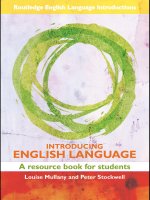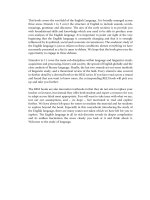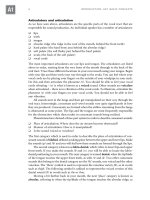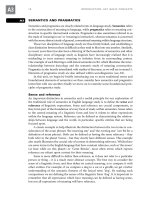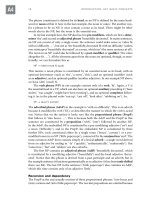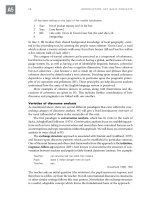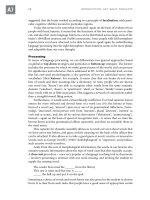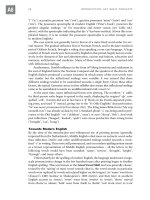Introdungcing English language part 5 pptx
Bạn đang xem bản rút gọn của tài liệu. Xem và tải ngay bản đầy đủ của tài liệu tại đây (316.21 KB, 6 trang )
10 INTRODUCTION: KEY BASIC CONCEPTS
SEMANTICS AND PRAGMATICS
Semantics and pragmatics are closely related terms in language study. Semantics refers
to the construction of meaning in language, while pragmatics refers to meaning con-
struction in specific interactional contexts. Pragmatics is also sometimes referred to as
the study of ‘meaning in use’ or ‘meaning in interaction’, whereas semantics is concerned
with the more abstract study of general, conventional meaning within language structure.
These two disciplines of language study are thus firmly linked, and establishing a
clear distinction between them is difficult as they tend to blur into one another. Similarly,
in recent years there has also been a blurring of the boundaries of semantics and other
disciplinary areas of language study as linguists have increasingly realised that it is
misleading to treat sentence meaning in isolation from its surrounding context.
One example of such blurring is with lexical semantics in B2, which illustrates the inter-
relationship between lexicology and the semantic study of meaning construction.
Pragmatics is also heavily interrelated with studies of discourse, as we will see in strand 5.
Elements of pragmatics study are also utilised within sociolinguistics (see A9).
In this unit, we begin by briefly introducing you to more traditional terms and
foundational elements of semantics; we then consider how semantics and pragmatics
interrelate with one another; finally we move on to examine some foundational prin-
ciples of pragmatics study.
Sense and reference
An important distinction in semantics and a useful principle for our exploration of
the traditional role of semantics in English language study is to define the sense and
reference of linguistic expressions. Sense and reference are crucial components, as
they form part of the foundation of every facet of study within semantics. Sense refers
to the central meaning of a linguistic form and how it relates to other expressions
within the language system. Reference can be defined as characterising the relation-
ships between language and the world, in particular, specific entities that are being
focused upon.
A classic example to help illustrate the distinction between the two terms is con-
sideration of the noun phrases ‘the morning star’ and ‘the evening star’ (see B4 for a
definition of noun phrase). Both can be defined as having the same reference – they
both refer to the planet Venus – but they clearly have different senses. This example
also neatly illustrates the crucial role of context in determining reference. Whilst there
are some terms in the English language that have constant reference, such as ‘the moon’
(at least while on this planet) or ‘Great Britain’, most often terms which express
reference are reliant upon context for their meaning.
Sense is more difficult to define than reference, as it does not refer to a particular
person or thing – it is a much more abstract concept. The best way to consider the
sense of a linguistic form, and thus define its central meaning, is to compare it with
other entities. For example, if we compare a dog to a cat or a giraffe, we get a better
understanding of the semantic features of the lexical term ‘dog’. By making such
comparisons we are defining the senses of the linguistic form ‘dog’. It is important to
remember that all expressions which have meaning can be defined as having sense,
but not all expressions of meaning will have reference.
A3
SEMANTICS AND PRAGMATICS 11
A key concept when defining reference is the term referring expression, denot-
ing a word or phrase that specifically defines a particular entity in the world. Noun
phrases are classic examples of referring expressions. However, as we have seen above,
it is important to bear in mind that reference cannot be ascribed in a vacuum.
Reference is context-dependent, and ascertaining the meaning of particular referents
depends entirely upon who is speaking, whom they are speaking with and in what
setting the interaction is taking place.
Some utterances may be referring expressions in one context but not in another.
For example, indefinite noun phrases need to be viewed in context – on some occa-
sions they will be referring expressions, on other occasions that will not fulfil this func-
tion. Compare the utterance ‘A woman was just staring at you’ with ‘This apartment
needs a woman’s touch’. In the former example, ‘a woman’ is a referring expression
but in the latter example it has indefinite reference: it does not refer to one
particular woman and so it is not operating as a referring expression in quite the
same way.
Can you think of other, similar examples where the same phrase has different
reference, depending upon context? The contextual difference between the same
referring expression can be exploited for humorous purposes. In the Irish television
situation comedy Father Ted, Father Ted comments to Father Dougal that their
parochial house is in need of ‘a woman’s touch’. Unable to understand the indefinite
reference, Father Dougal accuses the only woman who is present, a visiting nun, of
physically touching Father Ted – making the accusatory statement ‘Ted said you’ve
been touching him’. Dougal has failed to understand Ted’s indefinite, metaphorical
meaning, resulting in humour through his interpretation of ‘a woman’ as having lit-
eral, definite reference.
The blending between the study of semantics and meaning in context (pragmatics)
can be further illustrated by the related concept known as deixis. The term deixis is
borrowed from Greek, and translates as ‘pointing’. The English language, along with
all other languages, contains a specific set of words known as deictic expressions which
will vary in meaning depending upon who is using them, where they are being uttered
and when they are being uttered. The crossover of deixis between the two linguistic
sub-disciplines of semantics and pragmatics results in the term being defined and
discussed within both disciplines of language study.
Deictic expressions always take their meaning from some aspect of the context in
which they are uttered. These words all operate as indexes of specific meaning in con-
text and thus belong to investigations of what is commonly known as the indexical-
ity of language. Many referring expressions can be seen as belonging within the category
of deixis (for example ‘you’, ‘we’, ‘there’, ‘yesterday’). Some modifiers with deictic
reference are used alongside referring expressions such as demonstrative pronouns,
as in ‘this dog’, ‘that woman’, ‘these tables’, ‘those helicopters’, in order to help inter-
locutors identify the particular referents of a referring expression. It is also possible
for some verbs to be deictic too. For instance, ‘come’ and ‘go’ are good examples of
verbs that give evidence of location, and thus qualify as deictic expressions.
In order to consider deictic expressions from a more systematic perspective,
they can be usefully grouped into the following categories. The three most common
deictic sub-types are as follows:
12 INTRODUCTION: KEY BASIC CONCEPTS
Person deixis: I, you, her, Peter, Louise
Place deixis, sometimes referred to as spatial deixis: here, there, this, that
Time deixis, sometimes referred to as temporal deixis: now, today, yesterday,
tomorrow, next month
Social deixis is another category which is sometimes used. It includes referring
expressions which clearly encode social meaning. In modern English, this includes
categories known as address terms where social status is indexicalised through the
linguistic terms that we use, for example ‘Madam’, ‘Sir’, ‘Professor’, ‘Doctor’, or through
the more informal terms of endearment such as ‘mate’, ‘love’ or ‘flower’. Social en-
coding was once included with English pronoun usage through the use of ‘thou/you’.
Such pronoun usage is termed the T/V system of address (named after the French pro-
nouns ‘tu/vous’) and it is still present in many languages other than English, including
French and German.
One further deictic category is known as discourse deixis. This applies to forms
such as ‘the former’, or ‘the latter’, ‘when I said that . . .’, where such expressions are used
to point backwards or forwards to particular moments within written or spoken texts.
Studies investigating pragmatics in the English language have grown rapidly in
recent years. This growth can arguably be traced to a shift in language researchers’
focus, from being less interested in language as a theoretical, abstract system with
idealised speakers, to being more interested in actual language usage. Most recently this
has been dominated by a focus upon the interactions of specific speakers in real-world
contexts.
Speech Act Theory
Speech Act Theory is a foundational part of the study of pragmatics. It was originally
developed by philosopher J. L. Austin (1975) as an attempt to explain the processes
of how meanings are constructed within conversation. Speech acts are defined as what
actions we perform when we produce utterances.
Austin characterises a three-part system for describing different components of
speech acts:
Locution: what the speaker literally utters, and, drawing upon semantic termin-
ology, consisting of sense and reference.
Illocution: the force of what has been said, defined by social convention in the
context in which it is uttered. The locutions ‘Do that now’, ‘What time is it?’ and
‘Buster is six years old’ have the illocutionary force of a command (an impera-
tive), a question (an interrogative) and a statement (a declarative) respectively
(see B4).
Perlocution: the actual effect of the utterance: exactly how it is interpreted by the
hearer(s).
Ideally, the perlocution should match what the speaker intended, but this is not always
the case. Unintentional effects may well result, and on occasion this can result in
miscommunication or even communication breakdown. Other utterances are
ambiguous and it can be difficult to assign the exact perlocution. Also, if the sincerity
of the utterance is called into question then this can also affect the perlocution of the
SEMANTICS AND PRAGMATICS 13
utterance (see below). It is worth noting at this point that the term ‘illocutionary force’
is sometimes known by its longer definition illocutionary force-indicating device.
Examples of illocutionary force-indicating devices are ‘I’m sorry’ and ‘I apologise’, oper-
ating to signal the speech act of apology (further discussed in C3).
Austin also devised a category known as a performative speech act. This term can
be applied to an utterance which simultaneously performs the speech act as well as
describing the act itself. Most performative speech acts take the form of first person
+ performative verb as in ‘I promise’, ‘I apologise’, ‘I inform you’, ‘I warn you’.
In order for all speech acts, including performatives, to be described as success-
fully produced, then a set of criteria known as felicity conditions needs to be fulfilled.
According to Austin (1975), there are three different elements to felicity conditions.
The first is that a conventional procedure should exist for what is being carried out.
The second condition is that participants within the event need to fulfil their roles
properly. This can include enacting professional role responsibility appropriately, such
as the job of a qualified registrar to perform a marriage ceremony.
Thirdly, the necessary thoughts and intentions need to be present in all partici-
pants. Within this third category lie sincerity conditions: a participant must be
sincere about the act in order to fulfil this condition. For example, if a speaker utters
‘I’m really sorry I disturbed you’ when they have woken you up by telephoning, and
they are sincerely sorry that they have disturbed you, then the sincerity conditions have
been met. If they are not genuinely sorry, then this is not a legitimate apology.
These conditions can often be difficult to gauge in everyday conversation, due to
our inability to read speakers’ minds and also due to the potential ambiguity of cer-
tain utterances. Though speakers often give verbal and non-verbal clues as to whether
we can interpret their utterance as sincere or not, including intonation (voice pitch)
and body language, ultimately, sincerity will be ambiguous on some occasions. As inter-
actants we may well spend time after a speech event has taken place pondering over
exactly what someone has said to us, to try to ascertain their intention.
Speech acts can be further categorised as either direct or indirect. A direct speech
act is where the meaning of the utterance is literal, so the meaning is the sum of
its constituent parts. An example of a direct speech act is the following question:
‘Are you coming to the theatre tonight?’, uttered by a speaker to his housemate,
where the speaker genuinely wants to know whether his housemate is coming to the
theatre that evening.
Compare this direct example with the following utterance: ‘Can you pass the remote
control?’ uttered between the same two speakers in their living room while they are
watching television. This utterance is also interrogative in form. However, despite its
form, the illocutionary force behind this utterance is actually a command not a ques-
tion. The speaker wants the remote control given to him – he does not want to know
whether the hearer is literally capable of passing the remote control to him. This is
an indirect speech act, where the meaning of the utterance depends upon context and
the hearer’s ability to interpret the implicature contained within the utterance.
Indirect speech acts regularly occur in everyday conversations. They play an
important role in pragmatics study, and in the study of politeness in particular. We
will develop this focus on the important interplay between speech acts and linguistic
politeness in B3 and C3.
14 INTRODUCTION: KEY BASIC CONCEPTS
In preparation for this, think of examples of indirect speech acts which have taken
place in your everyday conversations. Decide upon the difference between the illocu-
tion and perlocution of the indirect speech act. What do you think the consequences
would have been if direct speech acts were used instead?
GRAMMATICAL PARTS
As native speakers of a language, we all have the rules of that language interiorised in
our minds: we know how to express just about any concept, event, state or argument,
and we also recognise how not to articulate these things. Our interiorised rules are not
easy to discover, and there are many dozens if not hundreds of different theories which
try to set out precisely what those patterns are. These theories about how language works
are called grammars, and they can differ from each other quite radically (even talking
about the ‘rules’ of language would be contentious for some grammarians).
We know that English (and every other language) undoubtedly has a grammar, since
it is possible to imagine utterances using the vocabulary of the language that are never-
theless badly formed: ‘?book the table the down put on’, ‘?to to or be be the question not
that is’, ‘?was beginning the in word the’. We must already have a set of well-formedness
rules in our minds to recognise these as ungrammatical, rather than as their resequenced
proper forms. Deciding what the constraints are that produce only the good sentences
is a difficult and debatable matter. There is, then, no such thing as ‘the grammar of
English’, only different grammars of English with different emphases and principles.
Constituents
Having said all that, there are some broad matters of consensus about what any gram-
mar needs to account for, and these patterns will be described in this unit. Firstly,
there are a finite number of words in the language, but a very very large number of
possible utterances, and native speakers are creative, in the sense that it is possible to
utter a string of language that has never been uttered previously. You can be novel
either by collocating two or more words together that do not usually go together, or
by extending your utterance with longer and longer material that quickly produces
a permutation that must be unique. In spite of this, and in spite of the related
problem that language and its rules are constantly changing, communication happens.
This astonishing set of facts relies on at least three properties of English that most
grammarians would agree on: constituency, dependency and recursion.
When we want to say something, we do not simply reproduce a combination
of set phrases in an unstructured way. Every utterance that is well formed displays
constituency. Every sentence is not simply a list of individual words, but can be
seen to be a systemic structure of words in well-formed phrases, and these phrases are
in well-formed positions in clauses. Further down the grammar, words are constituted
of morphemic ‘chunks’ in the correct pattern, and phonologically allowable structures
within those morphemes. Further up the grammar, the well-formed clauses combine
in proper ways in sentences and texts and extended discourse.
A4
GRAMMATICAL PARTS 15
If you take the last sentence of that paragraph, the comma marks out a mean-
ingful chunk that goes before it. You could draw lines round other meaningful
chunks as follows:
the well-formed clauses
/
combine
/
in proper ways
/
in sentences and texts and extended
discourse
It would be odd to carve up this sentence as follows:
the
/
well-formed clauses combine
/
in proper
/
ways in sentences and
/
texts and extended
/
discourse
The fact that this last version looks odd shows that you have an interior sense that
your language has a constituent structure.
Furthermore, that sense of structure can be understood independently of the
meaning of the words that are involved. For example, all the following sentences (and
many others you might think of) have exactly the same syntactic structure:
The well-formed clauses combine in proper ways in sentences and texts and
extended discourse.
An especially fat man arrives in good time before me and you and almost everyone.
Some semi-skimmed milk pours without a splash into flour and eggs and the fruity
mixture.
A nineteenth-century traveller moved at top speed by horses and carriages and steam trains.
The beautifully decorated cakes fit with no difficulty into boxes and cartons and little
papercups.
The boundaries marked by the lines in the first example above show the constituent
structure of the sentence. ‘The well-formed clauses’ is a complete and meaningful unit:
in the sentence, this unit stands as the subject of the verb ‘combine’ that follows it,
and ‘the well-formed clauses’ is the theme of the sentence – the starting argument for
the propositional material that attaches to it afterwards. Equally, ‘an especially fat man’
is the subject of ‘arrives’; ‘some semi-skimmed milk’, ‘a nineteenth-century traveller’
and ‘the beautifully decorated cakes’ are all subjects and themes of their sentences.
These are all noun phrases or NPs. Each of the chunks in the first, properly carved-
up sentence is a phrase, and most grammarians agree that there are five types of phrasal
category in English:
noun phrase (NP) The well-formed clauses
verb phrase (VP) combine
adverbial phrase (AdvP) in proper ways
prepositional phrase (PrepP) in sentences and texts and discourse
adjectival phrase (AdjP) well-formed
or,
noun phrase (NP) The beautifully decorated cakes
verb phrase (VP) fit
adverbial phrase (AdvP) with no difficulty
prepositional phrase (PrepP) into boxes and cartons and little paper cups
adjectival phrase (AdjP) beautifully decorated
